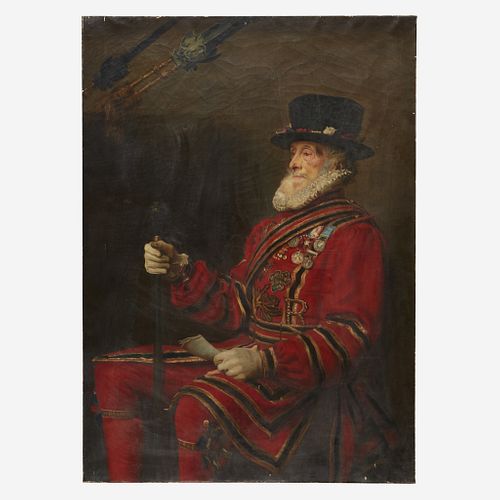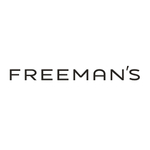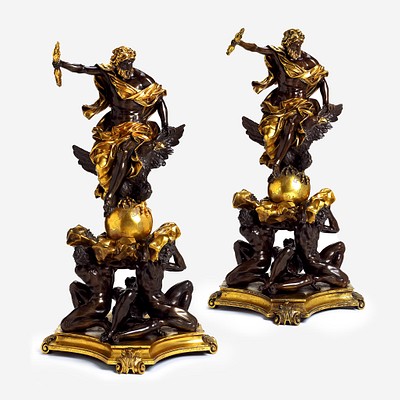After John Everett Millais (British, 1829–1896) and Studio The Yeoman of the Guard
About Seller
2400 Market St
Philadelphia, PA 19147
United States
Established in 1805, Freeman’s Auction House holds tradition close, with a progressive mind-set towards marketing and promotion, along with access to a team of top experts in the auction business. And now with offices in New England, the Southeast, and on the West Coast, it has never been easier to ...Read more
Two ways to bid:
- Leave a max absentee bid and the platform will bid on your behalf up to your maximum bid during the live auction.
- Bid live during the auction and your bids will be submitted real-time to the auctioneer.
Bid Increments
| Price | Bid Increment |
|---|---|
| $0 | $25 |
| $500 | $50 |
| $1,000 | $100 |
| $2,000 | $200 |
| $3,000 | $250 |
| $5,000 | $500 |
| $10,000 | $1,000 |
| $20,000 | $2,000 |
| $30,000 | $2,500 |
| $50,000 | $5,000 |
| $100,000 | $10,000 |
About Auction
Jul 14, 2021
A collection of European decorative arts and furniture. Curated by Laura Sevelis, Junior Specialist British & European Furniture & Decorative Arts. Freeman's info@freemansauction.com
- Lot Description
After John Everett Millais (British, 1829–1896) and Studio The Yeoman of the Guard
Illegibly inscribed and located 'London' verso; also with original preparer's stencil verso, oil on canvas
54 1/2 x 40 1/2 in. (138.4 x 102.9cm)
Unframed.
Executed in 1876.
(54 1/2 x 40 1/2 in.)Provenance
Private Collection
Acquired directly from the above
Private Collection, Arizona.
Footnote:Note
The present painting is one of several versions painted by Millais and his studio after the work now in the Tate Gallery, London referred to by Millais's son in his biography of his father. The painting depicts John Charles Montague, who had been a corporal and later sergeant in the 16th Lancers and served for more than twenty years in India. He distinguished himself on several occasions and wears his campaign, good conduct and long service medals. When he retired in 1847 he was appointed a Yeoman of the Guard. Montague died in May 1878.
This picture was painted in 1876, when Millais was then at the height of his fame. Its differences to his ground breaking Pre-Raphaelite work of the 1850s, are attested by his son:"In the summer of 1876 was painted 'The Yeoman of the Guard', a picture which, like the 'The North-West Passage', could hardly have been expected from the same hand as that which created 'Lorenzo and Isabella' and 'The Eve of St. Agnes', so widely different is it from either of them in character and sentiment. In 'The Yeoman' we have a splendid type of the fine old British warrior of which the nation is so proud a subject entirely after Millais' own heart. He delighted to paint it, and always considered the picture amongst the four best that ever came from his brush.
It was in 1875 that the idea of this work originated. Millais, having received a commission from a dealer to execute a very large picture of the Yeomen of the Guard searching the vaults beneath the two Houses previous to the opening of Parliament, made a preliminary visit to the Tower of London to see the "Beef Eaters" and study their costume. He was much struck with the splendid colour and tasteful design of the uniform, and thinking that under
artificial light its pictorial strength would be lost, he abandoned his original idea, and decided to paint a single figure in all the glory of the open air.
The difficulty was to find a model who came up to his ideal wearer of this historic costume; but this at last he found in Major Robert Montagu, a grand old man who most kindly came and sat for the head and hands. The Major had done yeoman service for his country in many campaigns, and his fine dignified head and figure were exactly what the artist required. Now, to sit to an artist for two hours involves a greater strain that is ommonly supposed. It is not surprising there fore that this old gentleman, who was over eighty and very infirm, found the work almost too much for him ; yet having once commenced he would not give in. He was supplied with soup etc. every three-quarters of an hour; and to relieve the strain on his gallant sitter Millais worked at a higher pressure than he had ever done before. The head and hands were dashed in, and completely finished in a few days; and yet, like so much of his best work, it suffered nothing from the rapidity with which it was executed.My uncle, Henry Hodgkinson, who was one of my father's most devoted admirers, and already owned 'Pizarro seizing the Inca of Peru' and 'The Woodman's Daughter' (both fine examples of the painter's earlier manner), had long wished for a specimen of his more recent works, but his limited means restrained him from indulging the desire. Now, however, when he saw 'The Yeoman' for the first time, he could no longer resist the temptation. The picture must be his at any cost; and he bought it. A proud man was he that day and ever afterwards of this possession…. When, later on, the artist expressed a desire that it should be left to the nation, he unselfishly jumped at the suggestion and carried it out by his will." (The Hodgkinson version of the painting was given to the Tate by Mrs Hodgkinson in 1897).
- Shipping Info
-
No lot may be removed from Freeman’s premises until the buyer has paid in full the purchase price therefor including Buyer’s Premium or has satisfied such terms that Freeman’s, in its sole discretion, shall require. Subject to the foregoing, all Property shall be paid for and removed by the buyer at his/ her expense within ten (10) days of sale and, if not so removed, may be sold by Freeman’s, or sent by Freeman’s to a third-party storage facility, at the sole risk and charge of the buyer(s), and Freeman’s may prohibit the buyer from participating, directly or indirectly, as a bidder or buyer in any future sale or sales. In addition to other remedies available to Freeman’s by law, Freeman’s reserves the right to impose a late charge of 1.5% per month of the total purchase price on any balance remaining ten (10) days after the day of sale. If Property is not removed by the buyer within ten (10) days, a handling charge of 2% of the total purchase price per month from the tenth day after the sale until removal by the buyer shall be payable to Freeman’s by the buyer. Freeman’s will not be responsible for any loss, damage, theft, or otherwise responsible for any goods left in Freeman’s possession after ten (10) days. If the foregoing conditions or any applicable provisions of law are not complied with, in addition to other remedies available to Freeman’s and the Consignor (including without limitation the right to hold the buyer(s) liable for the bid price) Freeman’s, at its option, may either cancel the sale, retaining as liquidated damages all payments made by the buyer(s), or resell the property. In such event, the buyer(s) shall remain liable for any deficiency in the original purchase price and will also be responsible for all costs, including warehousing, the expense of the ultimate sale, and Freeman’s commission at its regular rates together with all related and incidental charges, including legal fees. Payment is a precondition to removal. Payment shall be by cash, certified check or similar bank draft, or any other method approved by Freeman’s. Checks will not be deemed to constitute payment until cleared. Any exceptions must be made upon Freeman’s written approval of credit prior to sale. In addition, a defaulting buyer will be deemed to have granted and assigned to Freeman’s, a continuing security interest of first priority in any property or money of, or owing to such buyer in Freeman’ possession, and Freeman’s may retain and apply such property or money as collateral security for the obligations due to Freeman’s. Freeman’s shall have all of the rights accorded a secured party under the Pennsylvania Uniform Commercial Code.
-
- Buyer's Premium



 EUR
EUR CAD
CAD AUD
AUD GBP
GBP MXN
MXN HKD
HKD CNY
CNY MYR
MYR SEK
SEK SGD
SGD CHF
CHF THB
THB











